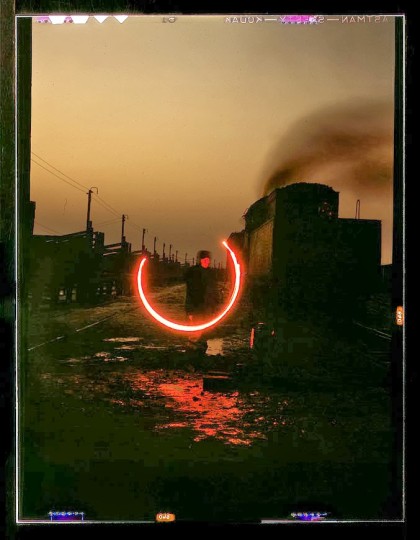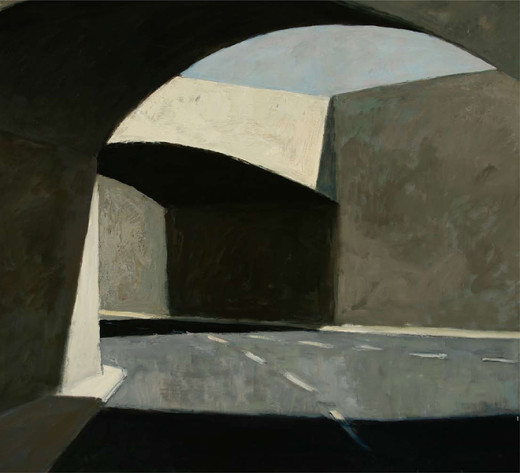
Ron Davis
“If negative dialectics calls for the self-reflection of thinking, the tangible implication is that if thinking is to be true – if it is to be true today, in any case – it must also be a thinking against itself. If thought is not measured by the extremity that eludes the concept, it is from the outset in the nature of the musical accompaniment with which the SS liked to drown out the screams of its victims.”
Theodor Adorno
“What are we to make of a mainstream media, along with the American public that appears more concerned about Kim Kardashian flaunting her post-baby body than about the Obama administration ordering a drone strike in Yemen that killed 17 innocent civilians who were part of a wedding party?”
Henry Giroux
DC Do you think it’s possible today to make paintings that are not about painting?
MB That’s very hard. I make paintings because my subject matter, to a large extent, is painting. The medium is not free from that—it’s very loaded.
there are more similarities between painting and film than between painting and photography. Before film, painting was about storytelling. Now film is about storytelling, though it wasn’t like that when it was invented. Today film is more like painting than ever before. Film itself is more and more rarely used for documentary purposes—everything is electronic or digital. But film has a language of beauty, like painting. It’s very appealing. That’s why they use it for commercials.
Michael Borremans,
Interview with David Coggins
Art in America
These are sort of interesting comments. I like Borreman’s work, and in fact, I think Belgium right now seems to have quite a few intriguing painters and filmmakers, and photographers, working in a way that seems uniquely Belgian. I’ve no idea, really, what is Belgian in what they do, but one does sense a clear connection between all of them.
One of the points in there is the fact that most film is about film. Most TV is about TV. This is not neccessarily bad, but it is usually bad and that’s because, obviously, so much of what gets made is part of the corporate system of image and narrative control. I think there is something worth looking at in how film relates to painting, and how it incorprates, or recuperates painting. Now, it is worth pointing out again, that this all takes place, this particular discussion, within a European tradition. A white European tradition. How that intersects today with a culture industry that promotes a clear white model, white paradigm, for almost everything, is not to be forgotten. But more on that below.
I wanted first, though, to discuss from another angle, an idea I put forward twenty years ago, and which feels relevant regards theatre. Regards the teaching of theatre, and by extension culture and the arts. The angle I wanted to approach it from is connected to both the above (painting about painting) and over-all, how film or TV works with those unconscious forces that live off stage. This idea of space, of the opening up of a space, is, in one sense, the entire reason people do theatre. From the Greeks to Beckett, the playwright must always be careful about who comes from ‘out there’; because out there is really the heart of things. On stage, and present, is a form of not being there. And herein lies the paradox or connundrum. For the actor who can be present, in some sort of Meditative sense, whether Buddhist or Hindu, Sufi or Christian mystical, becomes the repository for the attention of the audience. For the gaze of the audience. When I did my exchange here on the blog with Molly Klein, she suggested (speaking of my work) that it is possible these roles flip during the course of the play. I’d not thought of that exactly, but it’s certainly true. There is an apeture through which such energy passes. If you prefer we can substitute attention for energy, or whatever one likes. But the heart, the pulse of the play is always off the stage. It is always evoked by the playwright, through the actors. And so the messenger arrives. It is either the boy, as in Godot, or the talking hand in Genet’s The Screens, or it is the weary runner from the battlefield in Eurpides. It is worth noting that for Eurpides, there were servant (within the house) messengers, and there were messengers who were strangers. Often, the message came from those whose job it was to deliever such accounts, the official messenger. Often in Greek drama, there follows the narration of a message (that comes from off stage) by the messenger, the appearance of an altered central character (a blinded Oedipus, a mutilated and nearly dead Herakles, et al). The first person declarative message marked something significant in, at least, western stage craft. For what happens ‘out there’, in theatre (and not in film) is that things contract and condense. The universe is over-determined, much as Freud imagined our dreamwork. It is however more subtle in much modern theatre. In Godot, Pozzo and Lucky appear, and then leave, and then return altered. The problem is, as theatre began to predicate its storytelling on representations of the real, the roiling unconscious vortex, without limits, has a hard time finding a place in the play. The extremity of thought, as Adorno says above. That the extremity of narrative, of theatre as a form of thought, can only be found in work that assuredly assaults all expectation. And the worst offender to a denial of expectation is originality.

Jack Delano, photograher. 1940s, Indiana Harbor Belt Railroad switchman
But all theatre has created structures that enhance the idea of tapping into what is off stage. Just out of sight. In the wings. But the question of expectation is very important. What a viewer or reader “expects” to happen is almost completly a matter of conditioning, of training. In 19th century, and really 18th century painting, too, there were stories being told. The viewer would ‘read’ these stories. Certain things of a very abridged nature were expected to occur. I think Goya was one of the first painters to really use the idea of expectation. Nothing that goes on in the narrative of a Goya painting is expected. He is not really subverting expectation, not altogether, but he creating an idea of unresolve-ability. His paintings are stories in which it becomes clear, there will not, nor can there be, any solution. With Goya, there is always the presentation of open enigma.
But let me just clarify something, if I can. When one speaks of “whats going on”, as I did above, there is something too facile about that remark. Or ‘the heart of the play’, another expression I wrote above. What does that mean? Well, to me it means that the reason for this play, any play, “a” play to have been written is usually found in what’s not said by the author. In other words, there is always negative space. I know that directing I feel, always, as if I start with subtraction. Start to get rid of all that is cliched, or corny. And keep paring it down. In the writing of a play the paring and stripping down is usually about explanation firstly, and emotion secondly. Dont explain. Never explain anything. If it can be explained, it should be on TV. And second, if it cant be explained, then it will be about mourning or suffering in some respect, however deflected. Because otherwise, why bother to write? Its not like the world needs more plays. There are plenty of plays. Too many. Unless you cannot ‘not’ write it, then dont write it. The extremity of vision is always tragic I think. It is tragic because its been thought, its been put down on paper. Now, the biggest pot hole or trap for writers is to reach into someone’s elses grief. A friend, a painter, said that to me recently. I dont bother with the grief of others. But what he meant was, if it was too big. Some grief is too big for aesthetic consideration. I think this was Adorno’s point about Auschwitz. The creating of an artwork cannot be glib. Cannot be facile. Glibness is an ugly sort of indifference to suffering. And this is a society of extreme glibness. If one sees an accident, and an old man is crushed by a bus, and there is something in that story worth telling, it will reside in places other than the bus crush. When a novel was written, and later a film made, about a school bus going off the road and an entire small town had its children wiped out, I thought, well, you cant write about this. Its too big, its impossible. It is simply, as a subject, not something to make into a fiction. Im not sure you can make a documentary about it either (beyond my general distrust of that form) because its instantly voyeuristic. Cant be done. (Although, Sophocles comes to mind, but that exists in a very unique historical context).

Roger Kuntz
If someone steals a nickle and is hit by a bus and injured. If his or her leg is badly broken and she or he will limp for the rest of his or her life…..ok, that might be a fiction that can be written. It might even be documentary. It is concrete. The story’s magnitude of grief doesnt push the needle to red. And so, the author can explore what is embedded in that bus. But the bus that takes twenty five young children into an icy river grave, that hides forever whatever might be embedded. If you do a screenplay about an evil corporation poisoning people with an unsafe product, the best way to adapt it is to hope only two people died. If twelve thousand die, it can only be a news story.
And this is if we are writing about the corporation CEO. If he kills two people he can reveal some form of the truth of his life, of capitalsim, and of the masculine deformity caused by wearing suits and ties. But….if that CEO kills thousands, his life is erased. Fictionally speaking. For the crime resides in an historical system of larger crime. The predatory and violent nature of Capitalism simply eclipses most narrative on an idividual level.
But let me bring this back to paintings about paint. Films about film. However; plays about theatre. In a sense, theatre stands outside all the other mediums. I suspect because everything is a play. The stage is the ur-ritual space. Now, let me quote Paul Ricoeur, from his excellent and still significant study of Freud:
“..hermeneutics is understood as the manifestation and restoration of a meaning, addressed to me in the manner of a message, a proclamation, or as is sometimes said, a kerygma; according to the other pole, it is understood as a demystification, as a reduction of illusion…”
I suspect (never mind, as Jameson suggests, that this is so-not-post-modern) that two poles are on the first account, inhabited by artists, and the second by scientists and technicians. Or maybe just by non-artists.

Cargill research facility, beverage division
Adorno believed that a society cannot emancipate itself without art. And that what art expresses cannot be expressed any other way. Yet, what it expresses must be effected by the real world, and this is a core problem for aesthetic discussions. For the author of the artwork must either analytically, or instinctually, but somehow and by some means grasp something substantive about the world. He must grasp, as the philosopher does, something that can be recognized, and felt, but often, if not usually, not explained. If the author of the artwork is blind to the world, and when I say that I mean blind to suffering, to the reality of suffering, then the art that is made will be waste. Here the question of art’s autonomy is raised again. I think that the leftist response to the publication of Aesthetic Theory, which was never actually finished by Adorno, and which was published posthumously, mostly circled around this notion. Marxists at that time, and probably today, many of them, look for art to connect with praxis. It wont. It doesn’t. Or at least not at all directly.
But if what art expresses does not lead to practical revolutionary action, what good is it? Well, it is, or at least Adorno so thought, a sort of buffer to the mass slide into exaggerated Capitalist forms, in other words fascism. Culture and art give order to the most unformed and instinctual reptile brain parts of ourselves. I happen to think that this epiphanic and physical/emotional experience is, in a sense, part of the first stages of a cure for the emotional plague (Reich). Today, when someone identifies with their favorite TV show, that defense is usually couched in language of disproportionate passion. But it is not really passion, it is closer to zealotry. Put the fan back in fanatic. Still, it’s true. The identification is based on the constant recreating of the mass untruth of state domination. Of authoritarian and totalitarian social structures. Today, the near total erasure of depth experience to art has meant an increasingly sonambulent population. I had several interesting debates (not in comments for some reason) with friends about concept art (per the previous posting). And they argued that the experience of a Lawrence Weiner was just as deep and substantial as that of any other painter or sculpter. What I realized was, it is impossible to have this discussion without quite lengthy dialogue about mass marketing, hyper branding, and the growing screen life of today’s citizen of the West. For it is never so simple as “experiencing” the artwork. Still, I am happy to stand behind my comments on conceptual art. I think this is the first society in which forty and fifty year old adults exhibit such fan worship. Even forty years ago, the “fan” was relegated to teenagers. Today, one can find forty year old hysterical fan identification with TV shows.

John McCracken
Adorno said works of art are after-images of the empirically living. For him, they gave antidotes for societal untruth. It’s just that they did in varying ways. Each work had constructed its own laws. Now Adorno felt, and really Benjamin did too, only in another register, that art must be melancholy if it is to be art, in today’s world. But he meant this in the context of what was lost. Even that which, for Adorno, had no value, was to be mourned if lost. This was connected, I suspect anyway, with the exile trope which loomed so large for many of the Frankfurt thinkers. The exile, the stranger and the role of disenchantment, all come together in modern art. It is also directly connected to the loss of the sacred. And it at this point that I can return this meandering posting to the “off stage”. The offstage is cut off to the audience partly by the evolution of the physical building in which plays take place. The modern theatre, after about 1780 or so, had as a side bar job, to get rid of the magic of the wings or off stage area. The segregation of audience from the ritual. By extension today city planners model their re-development ideas on segregating classes. These are forms of erasure. A certain mechanistic illusion was established, and audience segregation enforced, until today, a trip to Lincoln Center is in the atmospherics of the place, much closer to a corporate boardroom, or laboritory at medical school (**note: read link at bottom of posting). The denuded world. That in which LIFE is minimized, and the dirt and insects are prohibited, or simply, chemically, removed. On a human level, this is how today’s political state deals with the surplus population. The problem of the poor. A growing problem. But more on that below. So, off stage is going, going, gone. And the rise of “performance art”, which ran alongside much conceptual and installation art, was the castrati tenor in history’s choir. The moisture and fecund danger that kept narrative alive had given way to the mechanical flats and realistic sets of most late 19th century theatre. I am writing in pretty broad stroke generalizations, here, I know. But I think part of the sanitizing of Freud, as his theory travelled across the Atlantic, could be seen generations down the road in the sanitized and emotionless flatness of installation video. It is the same aesthetic that has led to a brutalist architecture and the cleansing of public space, the loss of the commons. What Debord called generalized autism. The removing of background, which in a ruthless capitalist system means the removal of the poor. And I think part of this entire debate, about the experiential, is simply about submission. The analytic subsumes feeling. This has never been more clear to me than in this discussion. Nothing from the past echoes in these images. Only the idea of an echo.
Andrew Bowie, in writing about Adorno and art, said: “Without a certain kind of engagement with the object which can be a work of art, the object fails to make the specific aesthetic sense which is neither essentially cognitive, nor ethical, though it can involve aspects of both.” This is the path that leads to, I may not know what art is, but I know what I like. Its a very tricky discussion, especially today. I find myself confronting what I am going to call the ‘new populism’. This happens all the time and often I think what I hear is simply a default setting. People return to, oh, its all just subjective because they have no other position to articulate because they have never had to even try. So, back to the off stage and painters painting about paint. And about melancholy. Today, one senses a return of something more than just melancholy. Perhaps this is the front edges of what it feels like to face the denuded world. There is an aesthetic response, and it feels as if it can be found in extremity of form. And perhaps this can be seen in how genre seems to be more alive than that which aspires to formal independence. For it is only in genre, in a sense, that I feel the extremity of thought. In a week in which the mainstream news chose to cover Pussy Riot, and the increasingly strange saga of Glenn Greenwald and the pay-pal millionaire, and in which in the first case, the idiocy is palpable, the obvious movie-like qualities of the story hard to deny, and in the second, a strange sense of mental fatigue started to take over, for myself, and most people I spoke with. And this is the flip side of movie reality. If Pussy Riot is a teen action flick or something, then the Greenwald and Pierre Omidyar story felt closer to Manchurian Candidate meets The Candidate meets John Brunner maybe. Suddenly it is hard to find the right filmic parallel. Suddenly, Snowden starts to get confused in my head with Brian Botano, and then with Matt Damon. You see, Pussy Riot is just a dragstrip teen film, but with Russian chicks and a kitsch political cosmetic, but the Snowden and Greenwald story is closer to Henry James. And I know it’s not Henry James. And I know why Edward Said died speaking of unreality.

Theodore Gericault, self potrait of dying man
The social reality today is that over half the U.S. population lives in fear of their own total economic collapse. Increasingly the police departments of large cities, and small towns alike are openly attacking the poor. The abuse is directed at this growing population of insecurity. Increasingly, as I said before, there is a system that pathologizes the normal and normalizes the pathological. A recent TV mini series (Mob City) depicted real life 1950s L.A. police chief William H. Parker as a square jawed man of integrity bent on fighting a criminal underworld. The real life Parker was a sadistic and hyper racist authoritarian zealot. How does it work that he is cleansed and repackaged as a heroic figure? This is the corporate media reflecting the values of an elite 1%, the propriator class, and it is the construction of narrative that valorizes fascism. Bill Parker was a fascist. He conducted illegal attacks on dissent, spied on and murdered by proxy black dissidents in particular, and he created a police department in the image of a para-military cadre of puritanitcal white warriors. History is being rewritten, and within this revisionist narrative the victims are to blame. Anyone questioning authority is castigated as a troublemaker and deserving of violent punishment. Across the country today the police are modeled on the image created by Bill Parker. Yet, the mass media constructs entertainment that features a fantasy version of Chief Parker. The instruction and training of the American public is revealed in this just one example: and a fan culture embraces its favorite cultural commodities with an intensity and total lack of critical awareness. And across all of this is the constant of cartoon violence. For nothing is quite so normalized, now, as violence.
So if Michael Booremans paints about paint, this doesn’t mean his paintings are empty. It is why aesthetic education is important. Booreman also paints what we don’t usually see. He paints something that haunts us. I will quote Henry Giroux again here:
“Given the current crisis, educators, artists, intellectuals, youth and workers need a new political and pedagogical language for addressing the changing contexts and issues facing a world in which capital draws upon an unprecedented, ruthless appropriation of resources – financial, cultural, political, economic, scientific, military and technological -to exercise powerful and diverse forms of control.”
This is the key in terms of culture. Aesthetic resistance means aesthetic education firstly. And this is true for the left and the right. It starts with dismantling fan culture. Writing for profit means ethical compromise, usually. But admonishing anyone for making money to pay the rent is just the legacy of Cotton Mather at work. And it is also true that often artists cannot be trusted as the best critics of their own work. It means intentions are often mystified. But in today’s hyperbranded reality, everything is enclosed within a profoundly mediated discourse. There is ever less critical vocabulary to draw upon. The academic left is adrift in private games of mini-conquest, or in craven pandering to tenure and profit and visibility. The plague of careerism. One must learn to read well enough to recognize Pussy Riot for what it is, a crass pre-fabricated narrative courtesy of Madison Avenue and the U.S. state dept. The end result of this narrative drops one off at the same intellectual street corner that Mob City does. It is very difficult to avoid harmful generalizations in all this. For often, surprisingly, certain genre work is the most unsettling and disruptive to the master narrative. But one has to learn to read it, when it occurs that is.

Maria Sibylla Merian
Part of the problem with narrative today, after decades of kistch culture industry formula, is the acceptance of a “hero”. This notion translates in U.S. society today as “winner”. Ergo, a story about a community organizer, fighting for the rights of the impoverished, and black or latino to boot let’s say, is not going to be produced. Why? Well, firstly because such real life courage does not result in “winning”. In U.S. society today, courage means movie courage. Values and feelings are defined by their movie reality. Now, that protagonist (the community organizer) will not end up a millionaire, nor will he or she be able to beat the system and create protection and some sort of social safety net for his or her community. Even if this happens on occasion in real life (not often, but it does happen) the story contradicts too many of the established definitions of what “winning” means. Sacrifice is not portrayed as heroic, unless it is FOR the state (dying CIA agent, cop, soldier, etc). Dying on behalf of an ideal, well, forgetaboutit…unless, needless to say, that ideal is Capitalism and Imperialism. And oddly, even then, sacrifice is a murky theme for corporate entertainment. Movie sacrifice has a very restricted expression. Winning is much better. Winning period. I suspect that Hollywood film, and probably almost all major TV network drama, has since around 2000, narrowed its narrative down to even less ambiguous messages. The U.S. military is there to squash independent nationalist uprisings (often called terrorists)…either in opposition to business friendly monarchies (think the middle east) or those horrid South American marxists. In the same way Bill Parker is made a hero, the U.S. military is made heroic for wiping democratic movements off the face of the earth. The escalation of jingoistic message has coincided with the rise of poverty in the U.S. As more people become economically insecure, the themes of militarist heroism are more extensive, and less morally ambivalent. There is a growing divide in public opinion, even according to the system-friendly polling services, between the ruling Imperial class and the public. Hollywood film is made by people who are vassals of empire. They create, instinctively, if not consciously, messages tailored to Imperial needs. But this comes back to the idea of “hero” again. Of even having a “hero”. And that is because across the culture industry, in story meetings, various low level executives and D-girls are asking a young writer; “who do we root for”? Narrative is a football game. And there are always clear winners at sports contests. We root for the winner. By today’s standards, a defeat is only allowed, paradoxically, in films about sports, where losing a game means something like character building, the better to later win the game of life (become rich). Sports movies have the additional advantage of providing narratives that instruct poor minority youth in ideas such as honor and integrity, since they don’t by themselves ever figure this stuff out.
The “hero” today is a product of a long white colonial progression. How white history has forgotten, for example, the great civilizations of Africa. I’ve mentioned before the cartographic expression of Eurocentric values. The “hero” lives within a landscape of whiteness. All problems are white problems, or they aren’t problems in such stories. And this accounts for the vast majority of corporate entertainment. But there are exceptions, and I’ve mentioned a few over the last few months.
Finally (or almost finally) there is this: http://www.salon.com/2013/12/21/teaching_the_odyssey_at_san_quentin/
I am a sucker for these stories, partly because I’ve gone through the U.S. justice system, and secondly because I’ve later taught what is now called high risk youth (which really only means from poor backgrounds). There are reasons people tell stories. At some basic level, that remains true.

Thierry de Cordier
**As a footnote. This is worth reading. And when one has read to the end, remember, that the denuded world is exactly what Monsanto and Dupont and Syngenta and ConAgra and Cargill and Archer Daniels Midland want. Its what they all want. They have scientists who tell them this is all good, it all maximizes profit, it’s all scientific and what the future looks like. The death wish of Capitalism. http://www.npr.org/blogs/krulwich/2012/11/29/166156242/cornstalks-everywhere-but-nothing-else-not-even-a-bee

Could you name some of the Belgian filmmakers, painters, and photographers you mentioned briefly – I’d like to know more.
@alex
michael Roskam, and whilte Bruno Dumont is really French, he is sort an honorary Belgian, and Stijn Conninckx, and I guess Nik Balthazar. For painting…luc tuymans, Raoul De Keyser, and Roger Raveel, Dirk Braeckman (photographer), Pierre Alechinsky,Thierry De Cordier, and Patrick Van Caeckenbergh …. and the magnum photog Carl De Keyzer……and Jan Fabre does a lot of theatre as well as installation stuff. And Panamarenko …… another multi media artist. Guillaume Bijl and David claerbout……both work in photography and multi media.
oh, and Anne-Mie van Kerckhoven. and Berlinde De Bruyckere. Both more conceptual. But all of these artists seem to be working from a sensibility that isnt french and inst quite german. It is unique to belgium. And one more i forgot…..Hans Op de Beeck
John, this is an incredibly insightful post, and I have a lot of ideas that have come to mind, I’m just not sure how I can write them here. First, I’d like to say that Booremans comments at the top ring especially true to me. Although, I’d like to say that while film is about storytelling, I don’t think it is in the way that most people believe it is – and in this way cinema is very much like painting. I mean, when you watch a film, the script is perhaps only a third of the story, the rest comes from the actual language filmmaking – mainly direction and editing. As I’ve said before, the offstage in film for me lies in the negative spaces between cuts and edits, the temporal shifts in perspective that have a cause and effect quality to the elements onscreen, and in this case it’s important to differentiate between offstage (the unconscious) and offscreen (occurring at the same time as what is onscreen, but not seen).
I think storytelling is less reliant on a story and more about the way we choose to tell it. It becomes reflexive, and it can’t help but BE about the filmmaker. Very similar to painting. When we view a painting we will understand its subject, but what is more interesting, is the process of the painter, from conception to execution and perhaps even to exhibition. Painting is about painting and cinema is about cinema. I think it perhaps came to be that way after WWII, especially in Europe with Italian filmmakers, and then really took flight with Godard in the late 60’s and into the 70’s. I’m kind of rambling because I’m just starting to formulate these ideas, but I think we both agree that the storytelling in film isn’t what most people think of – and that’s why a mainstream pop film like Hunger Games feels so devoid of storytelling capabilities. The form chokes the content.
@joe
I agree. And i think the neo realist Italians did change a lot about storytelling in film. They started to invent a new vocabulary for film. They really did think about form. I find a lot of lesser directors of that time pretty tedious, but Rosellini was magical, and in his own way Visconti too. But….i think its very insightful to say the space between edits is the off stage of film. I dont think one can emphasize enough just now profoundly films are changed in the editing process. I saw this at the film school. Where literally a shot held a second longer utterly changed the meaning. And it changed it because of the duration allowed , or prevented, for the mimetic process of the viewer to re-narrate. I think Nick Ray was another director who instinctively grasped that storytelling wasnt in the script ….or mostly not. Godard of course has continued to look at this. Fassbinder did too. I mean berlin alexanderplatz is the strangest adaptation of a novel in the history of film. There are so many layers of meta narrative going on. So in a sense, the viewer is made to look at the paint. Its why in a weird say, with hyper realist painting I think something very interesting is at work. That stuff is so utterly unrealistic. They hide the paint, except they dont. So you discover the paint…..and suddenly the image changes. In film, there is another aspect here, and that is the discovery of the camera by the viewer. Songs from the Second Floor was a sort of exercise in that. And this is why hollywood blockbusters feel so enervating and dead. Nobody is thinking about any of this. And there is an entire discussion to be had about the aesthetic politics of steady cams. What is that doing? What does reference to a newsreel mean in a fiction film? Part of why I hated Act of Killing so much, besides the obvious racism and colonial politics was that it was such indept filmmaking. Its a large discussion.
As we’re talking about discovering the camera and the inner workings of the film, I can’t help but recall Bergman’s Persona. There is that sequence at the beginning when the film literally tears and reveals cinema’s tricks and skeletons – Melies and Chaplin – almost taunting the audience that what they’re seeing is a construction in the editing room. And that in itself is telling a story, or rather re-telling the same stories, cinema has told. The images of Chaplin and the characters of Melies have become gods, mythic, a kind of Dionysian unconscious – and they’re found buried deep within the images. What is interesting to me here is that they’re revealed at the moment when the film dissolves, the moment when the cut would have made. And that adds to this idea of the unconscious in the editing.
I’ve been reading Calasso’s “Literature and the Gods” and I’m so drawn to the idea of Holderlin coming across an apparition of Apollo in a German forest. If we were to think of the ways that the gods continue to appear to us mortals in art, they would have to do so in the hidden, dark spaces of celluloid and paint and poetry. Their shapes would shift into something modern, or perhaps unrecognizable. If you can, try to see Post Tenebras Lux, I’ve posted the trailer before, but the scene where the devil enters the household is deeply unsettling, since the satanic/divine has entered human consciousness again. I’m fascinated by these ideas, John.
Thats my favorite Calasso. I think its among the better essays on art in the 20th century in fact. And this is a great topic, the idea of retelling the same story. As Godard said, its all the same, just a little bit different. There are only so many stories. For what is a story? What is a character? I used to ask students, when you say you dont believe a character, what does that mean? The point is, as you say above, that the story is not the story. The story, or the real story as it were, is the telling. It is the listening and the processing and what we bring to our engagement with listening and viewing. I think the best film….take Blue Caprice this year….that film has a shot, of a car, the one with the two serial DC killers in it, from behind….following them at twilight….on the freeway. The score is beautiful. I cant explain to you why that one shot is so haunting. It is only in theory an establishing shot in a sense. But it is actually far more. It connects all the narrative details into something of a myth. Terrible things happen that most are oblivious of and yet, we sense somehow. It is a terrifying shot. This is the re-enchantment of the world in a sense. And that discussion is important, for that is what corporate kitsch does. It flattens out the world into this false scientific rationality. The world of disinformation and propaganda. And it is here that culture plays a significant political role, if only the left would ever grasp this. And its why I cite Adorno so often, constantly. For he grasped the nature of the culture industry while still devoutly believing in culture itself.,